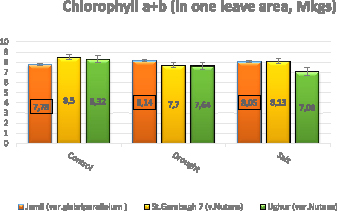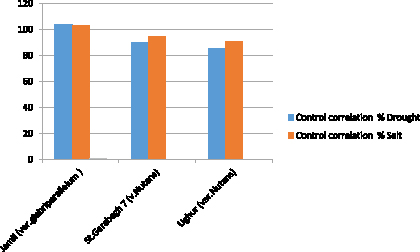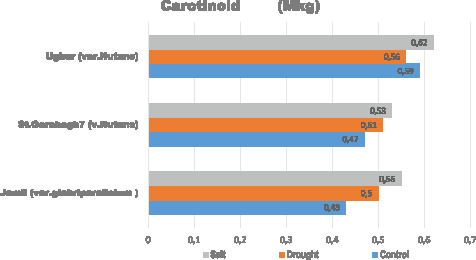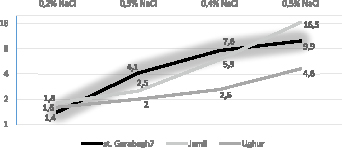Plants cultivated in natural and field conditions are always affected by stress factors. The most important of stress factors are drought and salinity. During their first effects, the body’s defense resources, energy resources are mobilized, and by resisting to harmful effects the organism is adapted to the conditions. If in this case, the stress effect stops, the physiological processes in the organism are normalized, but if the organism can not control the effect of harmful factors, the plant becomes weak and dye.
Drought stress is a meteorological event in the general sense and is a rainless phase that affects the development of plants. The resistance of the plants to drought stress is controlled by the genetic system and and changes depending on their genotype, degree and duration of water loss, developmental phase, age, organism and cell type. at all stages of growth and development, the plants need water, but the growing cells are more sensitive to water stress. Synthesis and accumulation of fat, starch and carbohydrates decrease due to drought stress, while the amount of proteins increases [1].
As a result of droughts, green plastids are split, which naturally leads to a decrease in the amount of chlorophyll. A reduction the amount of chlorophyll can be the result of adaptationduring weak drying and adaptation of plants to drought. Osmotic preservatives that help to regulate the osmotic potential in plant cells, susceptible to drought, are collected. Such osmotic preservatives include proline, betains, etc. can be shown [8].
Salinity is one of the factors that affect the productivity, the growth and development of the plants. The salt stress is the osmotic stress that plants are sustainable. Salt affects the development of plants negatively, slows germination, weakens growth, reduces productivity, and in some cases the plant dies.
Given all this, in recent years, the interest in research of physiological and biochemical processes occurring in plants in stressful conditions, which determines the sustainability of the plants to unfavorable environmental factors (drought and salinity)has been increasing. To this end, various diagnostic methods are used.
Materials and research methods
The study included three barley varieties: Jamil (Hordeum L. var. glabriparallelum), standard Garabagh 7 (Hordeum L. x Nutans), Ughur (Hordeum L. Nutans). Cemiland Ugur barley varieties were obtained by Garaybeyova Nargiz, the employee of the Genetic Resources Institute of ANAS. Different diagnostic methods were used in the study.
One of these methods is the study of the sustainability of the plants due to the stress occured by changes in the amount of chlorophyll (a + b) in the leaves. Study of sustainability in this direction was carried out on plants cultivated in the field. Studies of changes in the amount of chlorophyll under the effect of drought and salt stress have been made on the basis of the methodology proposed by the All-Russian Research Institute of Plant Industry [3]. For this purpose, the circles of plant leaves taken from the field during earing phase, placed in distilled water and osmotic solutions (20 atm sucrose and 14 atmNaCl). After 24 hours of stress, these circles were washed; dried and 96 % alcohol was added on them.
The amount of chlorophyll in the spectrophotometer (UV-3100 PC) was 2-wave length(E665-649 nµ) and the carotenoids content was 450 nµ after storage in dark place for 5-6 days (until full whitening of circle). After the effects of stress, the stress-depression rate was found by comparing the percentage of change of pigments (xl “a” and xl “b”) by control variant, and the resistance level of samples to stress factors was determined. The smaller the amount of pigments under stress means that the high resistance of samples.
Proline amino acid is also of great importance in the process of adaptation of plants to drought and salinity stress. In a physiologically normal condition, a certain amount of proline is transferred to the reproductive organs of plants [5]. It is important for the formation of acid seeds and pollen. There are many different ideas of explaining the causes of increased proline amino acids in stressful conditions. According to some authors, there is a positive correlation between the resistance of the plants and the amount of proline. Therefore, this indicator can be used as a biochemical marker of resistance.
Proline synthesis occurs by the pyrroline 5 carboxylatsinteza enzyme located in green chloroplasts and sytoplasma by glutamate way. But its dedragation occurs by the help of proline dehidrogenaza located in mitochondrias [6].
In the plants, a series of signals (Caions) and hormone mediators (Salicyl Acid) also help in the synthesis of the proline.
The amount of amino acid in proline was determined by the Bates [4] method at wavelength of 520nµ.
Research results and discussion
During stress in the plants a number of physiological and biochemical processes occur. Many of these processes are ptotective and adaptthe plants to the degraded environment. If the stress is not continued, the plant will be able to regenerate itself.
Morphophysiological and biochemical changes in plants under the influence of stress are studied by various diagnostic methods. One of the diagnostic methods used to determine plant resistance to stress factors is to study the changes in the amount of chlorophyll (a + b) in plant leaves under stress effect.
Changes in the amount of chlorophyll in the leaves due to the effects of drought and salinity stress are also reflected in our study. In addition to the effects on the physiological status of plants, the salinity and drought stress are significantly affected by the normal course of photosynthesis [1].
In the work of G.V. Udovenko, it is noted that under the influence of stress factors green plastids break down. This naturally leads to a reduction in chlorophyll content and in some cases a decrease in their volume [3]. This results in a weakening of the photosynthesis intensity. This process occurs mainly in unstable plants resistant to stressors, and more chloroplasts are observed to be weakened by photosynthesis intensity. However, there are also cases of increased chlorophyll levels due to stress. This is considered as the result of adaptation of plants to stress factors. This condition is usually observed in genotypes that are resistant to stress factors.
In our study, we investigated changes in the amount of chlorophyll (a + b) from the effects of salinity and drought stress on the leaves of the genotype of barley and tried to determine the relationship between this physiological indicator and plant resistance rates.
The study was conducted on 3 varieties of barley. The amount of chlorophyll (a + b) in 1-day stress leaves in 20 atm sucrose and 14 atmNaCl solutions was studied comparatively.
The studied barley samples reacted differently to stress factors. In some, the amount of chlorophyll (a + b) was reduced compared to control, and in some cases this amount increased (Fig. 1).
Due to the influence of stress factors on barley variety of Jamil, the amount of chlorophyll (a + b) increased by 4 % in drought and 3 % in salinity as compared with control. In the st.Garabagh 7 variety, due to stress factors there was a 10 % reduction in the amount of chlorophyll (a + b) and a 5 % decrease in salinity. The Ughur variety exposed to the effets of stress factors, where 15 % of chlorophyll (a + b) drought and 9 % depression in salinity were compared to control. According to the results, the Jamil barley variety is highly resistant to both stress factors, st.Garabagh 7 variety is more resistant to drought and salinity than the Ughur variety, and the Ughur variety is regarded as medium drought, salt-resistant variety.
The study showed that the samples studied were more resistant to salinity than drought. So compared to st.Garabagh 7, Jamil barley variety showed high resistance to drought and salt. Success sort is st. Compared to the st. Garabagh 7, Ughur was less resistant to stress factors (Fig. 2).
The study also investigated the variation in the amount of chlorophyll (a + b) under stress, as well as the amount of carotenoids that play a key role in the pigment system of plants (Fig. 2). Carotenoids are fat-soluble orange, red pigments, present in the chloroplasts of all plants, and they are in chloroplasts in non-green parts. Most chlorophyll in green chloroplasts make them invisible. They play an important role in the transfer of light as an added pigment and protect against chlorophyll molecules from irreversible photosynthesis.
As a result of the stress factors in the studied samples also occur changes in the amount of carotenoids. In some cases there was an increase in their number compared to controls, and in some cases a decrease was observed. The reason for this is that carotenoids play a defense role to return stressful chlorophylls to their previous condition, which is accompanied by an increase in their number.
The high tolerance of barley samples to salt stress is explained by the more active salt resistance genes in this plant.

Fig. 1. Determination of resistance of 3 barley samples to stress factors of drought and salinity due to the variability in chlorophyll (a + b)

Fig. 2. Determination of the resistance of 3 barley samples to the stress factors of drought and salinity ( %)

Fig. 3. Determination of resistance to stress factors of drought and salinity due to variability in carotenoids in 3samples of barley
We noted that a comprehensive study of stress resistance in several methods allows for more accurate information on resistance. Using these methods in the study, we tried to give an opinion of the salt resistance of Jamil, st.Garabagh 7 and Ughur varieties.
In the study, the ability to germinate seeds in 0.2, 0.3, 0.4, and 0.5 % NaCl solutions compared with 100 samples in each sample, the height of plants, the tolerance index by plant height, the amount of proline amino acid, and the increase of proline control to the increase of salt density was comparatively studied with the standard variant [Table 1].
It is known that salt stress negatively affects the germination of seeds due to osmotic limited water intake. During germination the seeds are exposed to high osmotic effects of the environment, and many physiological properties of the plant are determined by the suction force of the seeds [2]. Therefore, in laboratory conditions, the ability to germinate of plant seeds in NaCl solution is considered as the primary indicator of the salt resistance of plants. Of the studied samples, the seeds of Jamil barley variety germinated 98 %, 96 % in the st Garabagh7 and in the Ughur varieties. The number of seeds germinated in different percentage salt solution varied.
Thus, the number of germinated seeds of the Jamil barley variety was more than the varieties of Ughur and St Garabagh7. For example, in 0.2 % NaCl, the number of germinated seeds of Camil barley variety was 83, while in st Garabagh 7 this indicator was 69 and in Ughur varieties was 67. In the 0.5 % NaCl solution, the number of seeds germinated in the Camil barley variety was 41, in the st. Garabagh 7 variety was 30, and in the Ughur variety it was 32. Compared to the standard variant, the higher number of seeds of Camil variety in salt solutions give initial information about the salt resistance of this variety.
We have noted that stress factors affect certain physiological and biochemical processes of plants, making certain changes in these parameters, and as the effects of stress increase these changes are indicated saliently. Therefore, we measured the height of 20 plants from each of the three barley varieties germinated in different salt solutions and average figure was found. In experimental and control variants, a tolerance index by plant height was found based on the percentages of growth ratios in plants.
As can be seen from the table, the Camil barley variety was 18 cm in height and the other two varieties was 16.7 and 16.4 cm, respectively. In the 0.2 % solution of salt, the height of the germinating plants remained unchanged compared to control. However, salt solutions of 0.3-0.4 and 0.5 % had a significant effect on the height of the plants, as the salt content increased; the height was shortened as well. In the 0.5 % salt solution, height of Jamil variety is 10.7 cm tall, in st Garabagh7 is 6.8 cm and 5.6 cm in Ughur variety. The tolerance index of plant height was 59 cm in the barley variety of Jamil, 40 cm in the st Garabagh 7, and 34 in the Ughur variety.
According to the literature, the converse effect of high salt concentration on the plant is explained by a decrease in the amount of cytokine hormone stimulating growth of the plant and an increase in the absorption of the salicyl acid. In addition, high salt saturation and water deficiency inhibits the cell’s growth, affecting cell division and differentiation processes. The weakness of the plant grow this its adoptive hormonal response to salt stress [6].
In the plant cells exposed to stress accumulate osmotic preservatives that help regulate osmotic potential, and one of the most osmotic preservatives is proline [5].
It should be noted that during the effect of stress factors the non-used proline amount is accumulated, and this amount may also vary depending on the degree of stress. Our study also found interesting results regarding proline [Table].
The research was carried out on plant leaves, which were harvested in salt solutionsof different percent. As can be seen from the table, each controlbarley variety has specific proline content. This amount is sometimes much higher than the standard (Ughurbarley variety) and sometimes less (in the Jamil barley variety). However, the small and large amount of proline in the control form does not justify its continuity and is specific to each variety. However, there have been various changes in the amount of proline as compared to the control over the change of stress thickening. Thus, as the thickening of saltstress increased, the amount of accumulatedproline increased too.
However, this increase is different in different quantities for each species, for example, the rate of change of proline amino acid in comparison with control due to increased stress response in st.Garabagh 7 barley varieties is 1.4 in 0.2 % NaCl solution, 4.1 in 0.3 % NaCl solution, 0.4 % 7.6 in NaCl solution and 9.9 in 0.5 % NaCl solution.
It was found that the increase in prolineamount is gradual. Also, as the salt saturation in the Ughur barley variety increased, the rate of change of proline amino acid was 4.6 % in 0.5 % NaCl solution, while 1.6 % in 0.2 % NaCl solution. Correlation of theprolineamino acid with the control was most commonly observed in the Jamil barley variety. This increase was due to the gradual characterization of 0.2 % NaCl, 0.3 % NaCl and 0.4 % NaCl solutions, but increased from the effect 0.5 % saltsolution to 16.5 %. (Chart).
This increase in the amount of proline indicates that as salt concentration increases, it slows down in metabolic processes, accumulates without consuming proline, and protects the plant from dyeing.
Determination by different diagnostic methods of salt resistance of three barley varieties
|
Variants |
Germination ability of seeds (pc) |
Plant height (cm) |
Tolerant index by the plant height, % |
Amount of proline amino acid, Ml/mg |
Correlation of proline amino acid to control, % |
|
St. Garabagh 7 |
96 |
16,7 |
- |
0,16 |
- |
|
0,2 % NaCl |
69 |
16,5 |
98 |
0,22 |
1,4 |
|
0,3 % NaCl |
57 |
14,5 |
86 |
0,64 |
4,1 |
|
0,4 % NaCl |
36 |
9,0 |
53 |
1,2 |
7,6 |
|
0,5 % NaCl |
30 |
6,8 |
40 |
1,5 |
9,9 |
|
Jamil control |
98 |
18,0 |
- |
0,10 |
- |
|
0,2 % NaCl |
83 |
18,0 |
100 |
0,17 |
1,8 |
|
0,3 % NaCl |
65 |
16,8 |
93 |
0,25 |
2,5 |
|
0,4 % NaCl |
51 |
12,5 |
70 |
0,59 |
5,9 |
|
0,5 % NaCl |
41 |
10, 7 |
59 |
1,7 |
16,5 |
|
Ughur control |
96 |
16,4 |
- |
0,33 |
- |
|
0,2 % NaCl |
67 |
15,5 |
94 |
0,55 |
1,6 |
|
0,3 % NaCl |
55 |
14,0 |
85 |
0,68 |
2,0 |
|
0,4 % NaCl |
43 |
7,8 |
47 |
0,86 |
2,6 |
|
0,5 % NaCl |
32 |
5,6 |
34 |
1,5 |
4,6 |

Chart. Correlation of change of proline amino acid with control, in %
The literature indicates that there is a positive correlation between proline levels and plant resistance. Thus, we can say that among the three varieties of barley studied, Jamil barley is more resistant than st.Garabagh 7 variety and st.Garabagh 7 variety is more resistant than Ughur variety[7].
A comprehensive study of the salt resistance of the three barley varieties showed that the Jamil variety of barley had exceeded st.Garabagh 7 variety due to its many resistance indicators (seed germination, plant height, proline levels). This also suggests that Jamil barley variety is highly resistant to salt stress. According to the studied indicators Ughur barley varieties was rated as moderately resistant to salt stress, compared to the of st. Garabagh 7 variety.
Conclusion
1. The high salt tolerance of studied barley samples is explained by the more active salt resistance genes in barley plants.
2. Several diagnostic methods have revealed that Camil barley variety is highly resistant to salt and drought.

